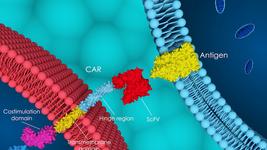CMN Weekly (5 April 2024) - Your Weekly CRISPR Medicine News
By: Gorm Palmgren - Apr. 5, 2024
Top picks
- A new Cas9/AAV6-based genome editing approach for autologous hematopoietic stem and progenitor cell transplant provides resistance to both CCR5- and CXCR4-tropic HIV-1. The method uses a simultaneous knockout knockin genome editing strategy in HSPCs, facilitating complete loss of CCR5-tropic replication and up to a 2,000-fold decrease in CXCR4-tropic replication without disruption of the CXCR4 locus.
- The La protein - a small RNA-binding exonuclease protection factor - is shown to be a pivotal enhancer of prime editing efficiency across various editing strategies (PE2 to PE5), edit types, and cell contexts. La's interaction with the polyuridine segments of prime editing guide RNAs boosts editing outcomes. Leveraging this, the researchers developed an advanced prime editor (PE7) integrating La's RNA-binding domain, enhancing editing with both expressed and synthetic guide RNAs. This discovery offers valuable strategies for improving prime editing by stabilising exogenous RNAs within cells.
Research
- A new gene therapy named MILESTONE, using CRISPR/nCas9 to edit the ELANE promoter, shows promise for treating severe congenital neutropenia (CN) by restoring neutrophil differentiation without impairing function. The approach introduces two single-strand DNA breaks at the opposing DNA strands of the ELANE promoter TATA-box, demonstrating over 90% on-target efficiency and a safe off-target profile.
- Researchers have developed a novel CRISPR-Cas9 delivery system utilising cryo-shocked lung tumour cells to target non-small cell lung cancer (NSCLC), particularly those with KRAS mutations. The technique involves using lung tumour cells treated with rapid liquid nitrogen shock, effectively inactivating their pathogenicity while preserving their structure and surface receptors. These cryo-shocked cells serve as carriers for CRISPR-Cas9, aimed at editing the CDK4 gene - a key player in the proliferation of KRAS-mutant NSCLC cells.
- A novel antibody-CRISPR-Cas platform offers targeted gene editing for HER2-positive cancers, enabling precise delivery and effective tumour suppression. By engineering Cas9 with an unnatural amino acid for complexing with nanocarriers and conjugation to HER2-specific antibodies, the approach allows for accurate delivery to tumour cells and has demonstrated efficacy in vitro and in vivo, particularly in disrupting the plk1 gene in ovarian cancer.
- An engineered CRISPR-dCas12a system for specific RNA visualisation in live cells uses a PAM-presenting oligonucleotide for target recognition. This system, highlighting its versatility and specificity, offers a new molecular toolkit for multiplexed RNA imaging, expanding the applications of RNA manipulation.
- A novel method for precise gene editing in adult organs utilises in vivo cleavable donor plasmids for CRISPR-Cas9 and CRISPR-Cas12a. The method employs hydrodynamic delivery of targeting plasmids, showcasing a substantial improvement over traditional techniques and significantly enhancing gene editing efficiency in adult mouse livers. The research conducted precise in-frame knock-ins using both CRISPR-Cas9 and Cas12a systems, successfully integrating reporter gene cassettes into targeted genomic loci in the liver of adult mice.
- A new acylation strategy using photolabile agents enables precise control over the CRISPR-Cas12a system, allowing for rapid activation with light. The innovative POIROT platform integrates this with recombinase polymerase amplification, achieving detection sensitivity superior to traditional assays and on par with qPCR but quicker. Apart from detection, the approach holds promise for advancing photo-controlled CRISPR applications in gene editing, therapy, and imaging.
- A new study employs an inhalable CRISPR-Cas9 gene editing system to target pulmonary macrophages, to modulate glucose metabolism to alleviate Acute Lung Injury (ALI). Employing aerosolised liposomal nanoplatforms for localised delivery, the researchers demonstrated that CRISPR-Cas-mediated downregulation of hexokinase 2 (HK2) - a key enzyme in macrophage metabolism and inflammation - significantly reduces macrophage glycolysis and inflammation.
- A genome-wide CRISPR screen has identified PKMYT1 as a therapeutic target in pancreatic ductal adenocarcinoma (PDAC). Functional validation showed that higher PKMYT1 expression levels indicate poor prognosis in PDAC patients. At the same time, PKMYT1 ablation inhibits tumour growth and proliferation in vitro and in vivo by regulating cell cycle progression and inducing apoptosis.
- A CRISPR knockout screen has identified GPAA1, a key enzyme in protein anchoring, as a regulator of the "don't eat me" signal CD24 in ovarian cancer, facilitating immune evasion. Disrupting GPAA1 diminished CD24 on cancer cells, boosting their removal by macrophages and hindering tumour growth in mice. The study also demonstrated that bestatin, an aminopeptidase inhibitor, effectively targets GPAA1, offering a promising immunotherapeutic strategy against CD24+ ovarian cancers by enhancing their susceptibility to immune clearance.
- A Finnish study demonstrates a CRISPR-based therapy for argininosuccinate lyase deficiency (ASLD), using lipid nanoparticles to deliver gene editors. This approach corrected the ASL gene in stem cells derived from ASLD patients, significantly reducing disease markers and restoring urea cycle function, showing promise for clinical application.
Industry
- 2seventy bio has terminated its oncology and autoimmune research and development programs, as Regeneron Pharmaceuticals has acquired these activities. The company will now focus exclusively on commercialising and developing Abecma, its BCMA-targeted CAR T cell therapy for multiple myeloma, primarily in quality and support functions.
- Verve Therapeutics has decided to pause its Phase 1 trial with VERVE-101, which targets the PCSK9 gene to lower LDL cholesterol. Initial results of VERVE-101 in five out of six patients show an average 46% lowering of LDL-C that lasts for up to 270 days. One patient, however, experienced Grade 3 drug-induced adverse events, including a transient increase in serum alanine aminotransferase (ALT) and thrombocytopenia. A commentary in Science addresses the news.
- Caribou Biosciences has received clearance for its Investigational New Drug (IND) application from the FDA for CB-010, an allogeneic anti-CD19 CAR-T cell therapy with a PD-1 knockout for the treatment of lupus nephritis (LN) and extrarenal lupus (ERL). CB-010 was initially developed to treat relapsed or refractory B cell non-Hodgkin lymphoma, but it has now been expanded to include autoimmune diseases. The Phase 1, multicenter, open-label GALLOP clinical trial of CB-010 in patients with LN and ERL is expected to be initiated by the end of 2024.
- iECURE has received clearance from the FDA for its Investigational New Drug (IND) application for ECUR-506. ECUR-506 uses the ARCUS genome editing technology to insert the ornithine transcarbamylase (OTC) gene to treat newborn males with genetically confirmed neonatal onset OTC deficiency. The disease can lead to coma, seizures, and brain damage and ultimately requires a liver transplant.
Detection
- A novel method combining methylation-sensitive restriction enzymes, CRISPR-Cas12a, and catalytic hairpin assembly amplification achieves highly sensitive and specific DNA methylation detection. Demonstrating a detection limit of 2 fM, it effectively differentiates colorectal cancer tissues from precancerous and healthy samples, promising advancements in early cancer detection and molecular diagnostics.
- A novel one-step recombinase polymerase amplification (RPA) and CRISPR assay for Vibrio vulnificus - the primary infectious pathogen for seafood-related deaths - employs a special crRNA targeting a sequence with a suboptimal protospacer adjacent motif (PAM). The entire assay, conducted at 37°C, takes only 40-60 min, yields results visualised under blue light and exhibits exceptional specificity and sensitivity (detecting four pathogen genome copies per reaction).
- A new electrochemical biosensor for the detection of B-type natriuretic peptide (BNP) - a biomarker for heart failure - is based on CRISPR-Cas13a and chain substitution reaction. The biosensor consists of a DNA aptamer that binds explicitly to BNP, a T7 RNA polymerase that amplifies the signal, a CRISPR-Cas13a system that cleaves the target RNA, and a two-dimensional DNA nanoprobe that generates an electrochemical signal.
- A novel CRISPR-based lateral flow assay, integrating LAMP amplification with CRISPR-Cas12a, offers rapid, reliable detection of Neisseria meningitidis, the pathogen behind meningococcal diseases. Tested on 139 patient samples, this method, targeting the ctrA gene, demonstrated a sensitivity of 91% and specificity of 99% against the gold standard, providing a promising tool for timely meningitis and meningococcemia diagnosis.
- A genotyping platform utilising dual toeholds and Cas12a overcomes PAM limitations, offering high specificity for SNP determination. Enhanced by an RPA-UDG strategy for sensitive biological sample analysis, it achieves 100% accuracy in identifying ApoE gene SNPs from buccal swabs. The addition of lateral flow strips for visual readout paves the way for practical, field-ready applications.
Reviews
- Application of CRISPR-Cas-based technology for the identification of tuberculosis, drug discovery and vaccine development. This review systematically summarises the current applications of CRISPR-Cas-based technology for TB detection and its potential roles in drug discovery and vaccine development.
- CRISPR-Cas9 Gene Editing: Curing Genetic Diseases by Inherited Epigenetic Modifications. This review critically evaluates CRISPR-Cas9's potential in treating genetic diseases, focusing on therapeutic applications, challenges, and future directions while emphasising the importance of informed use among medical professionals to maximise its benefits and mitigate risks.
- The CRISPR-Cas9 induced CCR5 Δ32 mutation as a potent gene therapy methodology for resistance to HIV-1 variant: a review. This review focuses on using CRISPR-Cas9 and hematopoietic stem cell transplantation to induce the CCR5 Δ32 mutation, offering potential HIV-1 immunity by blocking viral entry into CD4+ T cells.
- Systematic review and meta-analysis of genome-wide pooled CRISPR screens to identify host factors involved in influenza A virus infection. This review synthesises CRISPR-Cas screen findings on influenza A virus host factors, revealing new therapeutic target pathways and highlighting discrepancies with previous RNAi data, guiding future anti-influenza research.
- Advances and Challenges of Sensing in Water Using CRISPR-Cas Technology. This review delves into the prospective use of CRISPR-Cas technology for sensing in water, exploring its capabilities in detecting diverse biomarkers, hazardous substances, and varied reactions in water and wastewater systems.
Perspectives
- He Jiankui, known for his controversial creation of the world's first genetically edited babies, is back in the lab focusing on Alzheimer's and other genetic diseases. After serving a prison term for medical regulation violations, He is now working on human embryo genome editing, adhering to ethical standards and without intentions to produce more edited babies. Defending his past work, He claims the edited children are healthy and believes society will eventually accept embryo gene editing for treating genetic diseases.
To get more of the CRISPR Medicine News delivered to your inbox, sign up to the free weekly CMN Newsletter here.
Tags
CLINICAL TRIALS
IND Enabling
Phase I
Phase II
Phase III
IND Enabling
Phase I
Phase II
Phase III
Amyotrophic Lateral Sclerosis, ALS, or Frontotemporal Dementia FTD, (NCT04931862)
Sponsors:
Wave Life Sciences Ltd.
Sponsors:
Wave Life Sciences Ltd.
IND Enabling
Phase I
Phase II
Phase III







